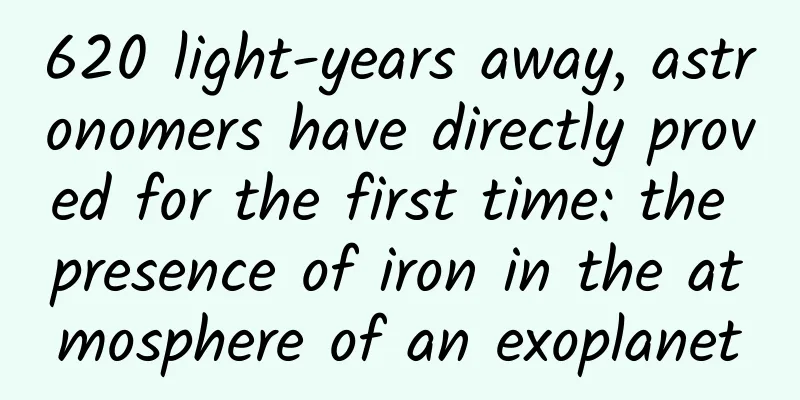620 light-years away, astronomers have directly proved for the first time: the presence of iron in the atmosphere of an exoplanet

|
[Mobile software: Bo Ke Yuan] An international research team led by astronomers from the University of Amsterdam has directly proved the presence of iron in the atmosphere of an exoplanet for the first time. The researchers found emission lines from uncharged iron atoms in the spectrum of the exoplanet KELT-9b. The observations were complicated because the exoplanet is eclipsed by its bright host star. The exoplanet KELT-9b orbits its star KELT-9 every 36 hours. The star and planet are located in the constellation Cygnus, about 620 light-years from Earth. The star is more than 10,000 degrees hot, almost twice as hot as our sun, and the planet KELT-9b is larger than Jupiter, but it is very close to the star, about one-thirtieth the distance from Earth to the sun. Astronomers already knew there must be iron in the planet's atmosphere; they saw signs of it years ago when studying starlight as the planet passed in front of it. In the new observations, astronomers looked directly at the planet's spectrum of light, a process complicated by the fact that the planet appears dimmed in the light of its star. Additionally, because it is so far from its host star, a year on this planet is only about a day and a half on Earth time. For half of this short year, the night side of the planet is facing Earth, but that side is too dim to be seen. Therefore, the researchers began observing the planet eight hours before it disappears behind its star, observing its hotter, brighter day side. Lead author of the study, Lorenzo Pino (University of Amsterdam), compared searching for the light of an exoplanet against the glare of its host star to looking at a firefly near a lamppost: Seeing the shadow of a firefly means, for researchers, the shadow of an exoplanet, and now an exoplanet has been seen directly. The researchers made the observations using the Italian telescope Telescopio Nazionale Galileo on the Spanish island of La Palma. The telescope features HARPS-N, a spectrometer that can split light and reveal the presence of specific atoms and molecules. The researchers extracted the atomic emission lines using a technique called cross-correlation. A series of images were compared: the star tends to be stationary, but the planet is moving. The cross-correlation is a filter that moves with the planet, which allows astronomers to isolate the planet's light. Based on the data, the researchers now believe that iron in the atmosphere of the exoplanet KELT-9b heats the upper part of the atmosphere, making it warmer than the lower part. The idea is that iron absorbs starlight, which heats the atmosphere. On Earth, a similar process occurs in the atmosphere, however, in this case it is not iron that heats the top layer, but ozone. In the future, the researchers hope to conduct more in-depth observational studies by precisely measuring the iron content in the planet's atmosphere. This could be achieved, for example, using the Hubble Space Telescope, to which Lorenzo Pino is assigned observing time. Ultimately, the astronomers hope to reveal how hot, gaseous giant exoplanets like KELT-9b emerge and why there are no similar examples in our own solar system. Bo Ke Yuan | Research/From: Netherlands Academy for Astronomy BoKeYuan|Science, technology, research, popular science Follow [Bokeyuan] to see more beautiful cosmic science |
<<: The largest pearl in the world is as heavy as a husky
>>: What would happen if you jumped from space with a parachute? Would you be able to land safely?
Recommend
The efficacy and function of Guanbai Fuzi
Guanbai Fuzi is something that many people are ve...
The efficacy and function of fermented glutinous rice
Everyone is familiar with fermented glutinous ric...
The ancient zither is present in paintings from the Song and Yuan dynasties, and the taste of the zither is pure joy
The ancient zither is present in paintings from t...
The efficacy of drinking water soaked with astragalus and black wolfberry
Wild black wolfberry is warm in nature and sweet ...
This bird has something to do with the brothel madam
In the past few days, three great bustards came t...
The efficacy and function of hanging lanterns
Hanging lanterns are a kind of traditional Chines...
eDigitalResearch: Average consumer satisfaction with apps for searching and planning travel is 83%
According to eDigitalResearch, the travel industr...
What are the benefits of drinking Cassia seed soaked in water?
Drinking Cassia seeds soaked in water has many be...
Another place, a 7.3 magnitude earthquake occurred! Has the earth entered "vibration mode"?
The China Earthquake Networks Center officially d...
Big Bear and Little Bear are fighting? Is there no room for two bears in one mountain?
Recently, the fight between two Asian black bears...
The efficacy and function of the inverted heart leaf coral
Traditional Chinese medicine culture is profound ...
The efficacy and function of loess
Loess is a medicinal material and is quite common...
Quantum communication: You don’t understand my “magic”
For more than 2,000 years, passwords have been th...
Xuzhou, how many legends are there?
This is a A city full of legends It is A battlegr...
The efficacy and function of hydrochloric acid tree
After thousands of years of sedimentation and acc...









